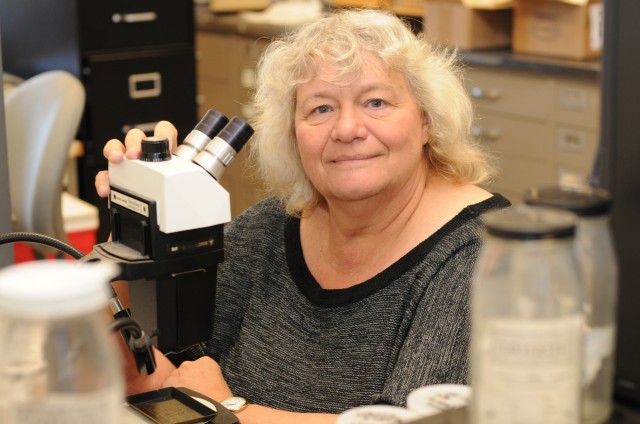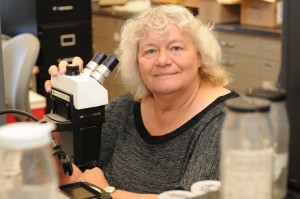Thomas’s Research on Marine Biota during a Period of Rapid Global Warming Published


Ellen Thomas, research professor of earth and environmental sciences, is the co-author of “Pteropoda (Mollusca, Gastropoda, Thecosomata) from the Paleocene-Eocene Thermal Maximum of the United States Atlantic Coastal Plain,” published in Palaeontologia Electronica, Article 19 (3) in October 2016.
The Paleocene Epoch lasted 65 to 54.8 million years ago and the Eocene Epoch lasted from 56 to 33.9 million years ago, and was a period of rapid global warming.
The response of many organisms to the Paleocene-Eocene Thermal Maximum (PETM) has been documented, but marine mollusks are not known from any deposits of that age. For the first time, Thomas and her co-authors describe a PETM assemblage of pteropods (planktic mollusks), consisting of six species representing three genera (Altaspiratella, Heliconoides and Limacina). Four species could be identified to species level, and one of these, Limacina novacaesarea sp. nov., is described as new. Only the genus Heliconoides was previously known from pre-Eocene sediments, with a single Campanian specimen and one latest Paleocene species.
The research team recovered pteropods from Marlboro Clay (United States Atlantic Coastal Plain), deposited at paleodepths from inner shelf (southern Salisbury Embayment) to middle-outer shelf (New Jersey Coastal Plain). Most living pteropod assemblages inhabit water depths of 200 meters or more, so their occurrence at shelf depths may reflect transport from more open waters.
During the PETM, pH in the upper waters of the ocean may have declined, but this did not cause dissolution of pteropods before they reached the seafloor, possibly due to buffering in coastal waters, Thomas explained.
“The apparently sudden appearance of three genera could reflect better preservation due to high sedimentation rates, since the underlying and overlying formations show poor preservation of calcareous microfossils,” Thomas said. “Potential ancestors, however, have not been found anywhere, so we consider it more likely that the rapid environmental changes during the PETM, such as temperature, runoff and nutrient fluxes, and ocean water chemistry, may have triggered pteropod diversification.”
Thomas also is the co-author of “Expanded Oxygen Minimum Zones during the Late Paleocene – Early Eocene: Hints from Multi-Proxy Comparison and Ocean Modeling,” published in Paleoceanography, Volume 31, Issue 12 in December 2016.
Anthropogenic warming could well drive depletion of oceanic oxygen in the future. Important insight into the relationship between deoxygenation and warming can be gleaned from the geological record, but evidence is limited because few ocean oxygenation records are available for past greenhouse climate conditions. In this study, the co-authors use iodine/calcium levels in benthic foraminifera to reconstruct late Paleocene through early Eocene bottom and pore water redox conditions in the South Atlantic and Southern Indian Oceans and compare their results with those derived from manganese speciation and the cerium (a soft, silvery-white metallic chemical element) anomaly in fish teeth. The researchers conclude that waters with lower oxygen concentrations were widespread at intermediate depths (1.5–2 kilometers), whereas bottom waters were more oxygenated at the deepest site, in the Southeast Atlantic Ocean (>3 kilometers). Epifaunal benthic foraminiferal iodine/calcium values were higher in the late Paleocene, especially at low-oxygen sites, than at well-oxygenated modern sites, indicating higher seawater total iodine concentrations in the late Paleocene than today.

